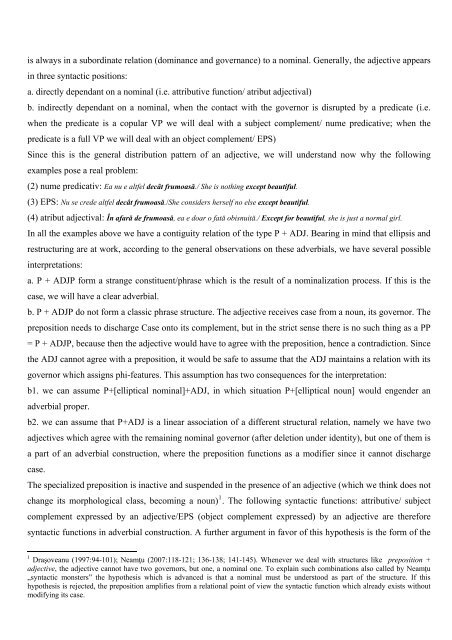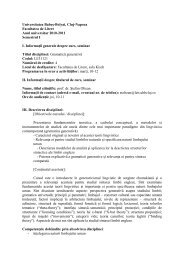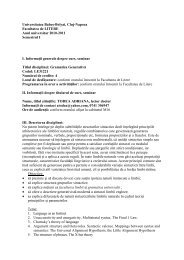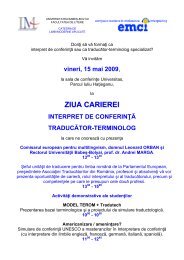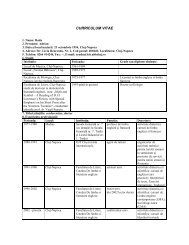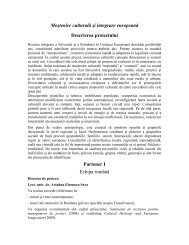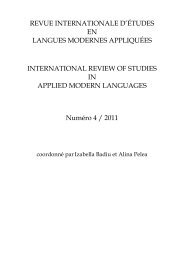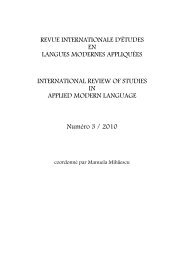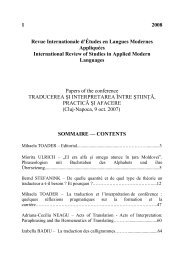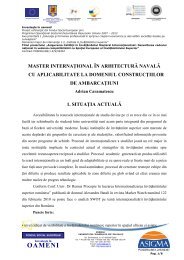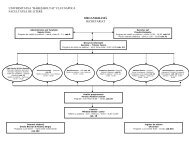Dimensiuni ale limbajului n context carceral
Dimensiuni ale limbajului n context carceral
Dimensiuni ale limbajului n context carceral
You also want an ePaper? Increase the reach of your titles
YUMPU automatically turns print PDFs into web optimized ePapers that Google loves.
is always in a subordinate relation (dominance and governance) to a nominal. Generally, the adjective appears<br />
in three syntactic positions:<br />
a. directly dependant on a nominal (i.e. attributive function/ atribut adjectival)<br />
b. indirectly dependant on a nominal, when the contact with the governor is disrupted by a predicate (i.e.<br />
when the predicate is a copular VP we will deal with a subject complement/ nume predicative; when the<br />
predicate is a full VP we will deal with an object complement/ EPS)<br />
Since this is the general distribution pattern of an adjective, we will understand now why the following<br />
examples pose a real problem:<br />
(2) nume predicativ: Ea nu e altfel decât frumoasă./ She is nothing except beautiful.<br />
(3) EPS: Nu se crede altfel decât frumoasă./She considers herself no else except beautiful.<br />
(4) atribut adjectival: În afară de frumoasă, ea e doar o fată obisnuită./ Except for beautiful, she is just a normal girl.<br />
In all the examples above we have a contiguity relation of the type P + ADJ. Bearing in mind that ellipsis and<br />
restructuring are at work, according to the general observations on these adverbials, we have several possible<br />
interpretations:<br />
a. P + ADJP form a strange constituent/phrase which is the result of a nominalization process. If this is the<br />
case, we will have a clear adverbial.<br />
b. P + ADJP do not form a classic phrase structure. The adjective receives case from a noun, its governor. The<br />
preposition needs to discharge Case onto its complement, but in the strict sense there is no such thing as a PP<br />
= P + ADJP, because then the adjective would have to agree with the preposition, hence a contradiction. Since<br />
the ADJ cannot agree with a preposition, it would be safe to assume that the ADJ maintains a relation with its<br />
governor which assigns phi-features. This assumption has two consequences for the interpretation:<br />
b1. we can assume P+[elliptical nominal]+ADJ, in which situation P+[elliptical noun] would engender an<br />
adverbial proper.<br />
b2. we can assume that P+ADJ is a linear association of a different structural relation, namely we have two<br />
adjectives which agree with the remaining nominal governor (after deletion under identity), but one of them is<br />
a part of an adverbial construction, where the preposition functions as a modifier since it cannot discharge<br />
case.<br />
The specialized preposition is inactive and suspended in the presence of an adjective (which we think does not<br />
change its morphological class, becoming a noun) 1 . The following syntactic functions: attributive/ subject<br />
complement expressed by an adjective/EPS (object complement expressed) by an adjective are therefore<br />
syntactic functions in adverbial construction. A further argument in favor of this hypothesis is the form of the<br />
1 Draşoveanu (1997:94-101); Neamţu (2007:118-121; 136-138; 141-145). Whenever we deal with structures like preposition +<br />
adjective, the adjective cannot have two governors, but one, a nominal one. To explain such combinations also called by Neamţu<br />
„syntactic monsters” the hypothesis which is advanced is that a nominal must be understood as part of the structure. If this<br />
hypothesis is rejected, the preposition amplifies from a relational point of view the syntactic function which already exists without<br />
modifying its case.


